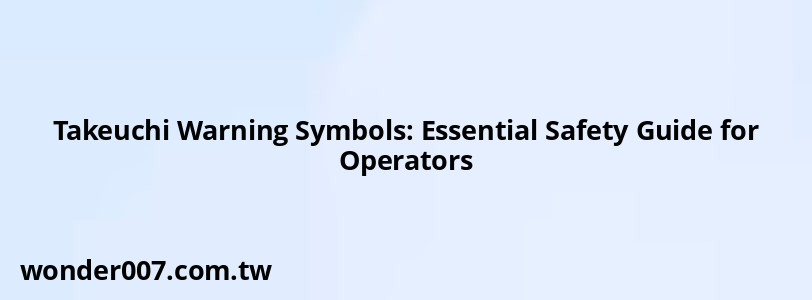Takeuchi Warning Symbols: Essential Safety Guide for Operators

Takeuchi warning symbols are critical for ensuring the safety and proper operation of their machinery. These symbols communicate important information about potential hazards, maintenance requirements, and operational alerts to operators and maintenance personnel.
Understanding Takeuchi Warning Symbols
Takeuchi employs a standardized system of warning symbols that help convey essential safety messages. These symbols are designed to be easily recognizable and understood by operators, regardless of language barriers. The primary categories of these symbols include:
- DANGER: Indicates a high-level risk that, if not avoided, could result in death or serious injury.
- WARNING: Signifies a medium-level risk that could lead to death or serious injury if not addressed.
- CAUTION: Represents a low-level risk that may result in minor or moderate injury.
- IMPORTANT: Alerts operators about situations that could cause damage to the machine and its components.
Each symbol is accompanied by specific instructions or warnings to ensure safe operation.
Common Warning Symbols and Their Meanings
The following table outlines some common Takeuchi warning symbols along with their meanings:
| Symbol | Meaning |
|---|---|
| ⚠️ DANGER | High level of risk; can lead to death or serious injury. |
| ⚠️ WARNING | Medium level of risk; could result in serious injury. |
| ⚠️ CAUTION | Low level of risk; may cause minor injury. |
| ℹ️ IMPORTANT | Alerts about potential damage to the machine. |
These symbols are typically displayed on the equipment's control panel, user manuals, and safety decals on the machines.
Importance of Compliance with Warning Symbols
Ignoring warning symbols can lead to severe consequences, including equipment damage and personal injury. Operators must familiarize themselves with these symbols and adhere strictly to the instructions provided.
Key practices include:- Regularly checking for any warning lights or alerts during operation.
- Following maintenance schedules as indicated by the machine’s information system.
- Ensuring all operators are trained on the meaning of these symbols before operating the machinery.
FAQs About Takeuchi Warning Symbols
- What should I do if I see a warning light?
If you see a warning light, stop the machine immediately and assess the situation according to the operator's manual. - Are there specific training requirements for understanding these symbols?
Yes, all operators should be trained on the meanings of these symbols as part of their safety instruction. - Can I ignore warning symbols if I am experienced?
No, all operators must pay attention to warning symbols regardless of experience level as they indicate critical safety information.
By understanding and respecting Takeuchi's warning symbols, operators can ensure safer working conditions, prolong equipment life, and minimize risks associated with machinery operation.
Related Posts
-
2006 Ford F150 5.4 Serpentine Belt Routing Guide
27-01-2025 • 203 views -
How To Reset DPF Warning Light
31-01-2025 • 160 views -
Kia Optima Trunk Latch Replacement: A Complete Guide
29-01-2025 • 279 views -
Crankshaft Sensor: Comprehensive Guide for 2007 Pontiac G6
29-01-2025 • 117 views -
Ford F250 Gear Shift Lever Replacement Guide
30-01-2025 • 172 views
Latest Posts
-
Are O2 Sensors Covered Under Warranty
01-02-2025 • 376 views -
Power Steering Fluid Leak On Passenger Side
01-02-2025 • 457 views -
How To Turn Off Paddle Shifters Mercedes
01-02-2025 • 377 views -
Rear Brake Caliper Piston Won't Compress
01-02-2025 • 356 views -
2015 Chevy Traverse AC Recharge Port Location
01-02-2025 • 409 views
Popular Posts
-
EPC Warning Light: What It Means for Your Vehicle
27-01-2025 • 630 views -
V12 Engine Costs: What You Need to Know
26-01-2025 • 679 views -
EPC Light: Understanding Causes and Solutions
26-01-2025 • 1053 views -
Power Steering and ABS Light On: Causes and Solutions
27-01-2025 • 643 views -
Hino Warning Lights: Understanding Dashboard Alerts
26-01-2025 • 765 views
